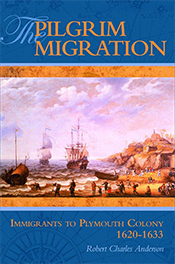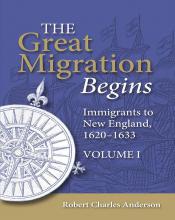THOMAS ROGERS
ORIGIN: Leiden, Holland
MIGRATION: 1620 in Mayflower
FIRST RESIDENCE: Plymouth
ESTATE: In the 1623 Plymouth land division Joseph Rogers was granted two acres as a passenger on the Mayflower, for himself and his deceased father [PCR 12:4]. In the 1627 Plymouth cattle division Joseph Rogers was the fifth person in the eleventh company [PCR 12:12].
Sons Joseph and John were each assessed the minimum 9s. in the 25 March 1633 rate [PCR 1: 11 ].
On 6 April 1640, “Joseph Rogers and John Rogers, his brother,” were granted fifty acres of upland each at the North River. [PCR 1:144].
BIRTH: By about 1572 (based on date of marriage), son of William and Eleanor (_ ____ ) Rogers of Watford, Northamptonshire [TG 10:143].
DEATH: Died Plymouth soon after arrival, probably in January or February 1620/1.
MARRIAGE: Watford, Northamptonshire, 24 October 1597 Alice Cosford, daughter of George Cosford [TG 10:140].
CHILDREN (baptized Watford, Northamptonshire [TG 10:140]):
- THOMAS ROGERS, bp. 24 March 1598/9; bur. 27 May 1599.
- (possibly) RICHARD ROGERS, bp. 12 March 1599/1600; bur. 4 April 1600.
- JOSEPH ROGERS, bp. 23 January 1602/3; m. by 1633 Hannah __ (assuming she was his only wife; eldest child of Joseph Rogers b. 6 August 1633 [MD 16:238]); appears in "1633" list of Plymouth freemen in vicinity of others admitted on 1 January 1632/3 [PCR 1 :4 ]; assessed 9s. in the Plymouth tax lists of 25 March 1633 and 27 March 1634 [PCR 1 :11, 28]
- JOHN ROGERS, bp. 6 April 1606; assessed 9s. in the Plymouth tax list of 25 March 1633 [PCR 1: 11 ]; m. Plymouth 16 April 1639 Anna Churchman [PCR 1:120].
- ELIZABETH ROGERS, bp. 26 December 1609; living at Leiden in 1622, perhaps came later to New England and married there [TAG 52:110-13; Bradford 446].
- MARGARET ROGERS, bp. 26 December 1609; living at Leiden in 1622; perhaps came later to New England and married there [TAG 52:110-13; Bradford 446].
COMMENTS: In his listing of the passengers on the Mayflower Bradford includes "Thomas Rogers and Joseph his son; his other children came afterwards," and in his accounting of these families as of 1651 Bradford tells us that "Thomas Rogers died in the first sickness but his son Joseph is still living and is married and hath six children. The rest of Thomas Rogers's came over and are married and have many children" [Bradford 442, 446].
Robert S. Wakefield and Jeremy D. Bangs have discussed the 1622 poll tax for Leiden which revealed Thomas Rogers's widow and children living in the Over 't Hoff quarter of Leiden [TAG 52:110-13; NEHGR 154:432-33]. Since the widow, son John and daughters of Thomas Rogers were not in the land division of 1623 or the cattle division of 1627, they presumably came to Plymouth with the last of the Leiden contingent in 1629 or 1630.
BIBLIOGRAPHIC NOTE: In 1998, Clifford Stott demonstrated the English origin of Thomas Rogers [TG 10:138-49]. In 2000 the Five Generations Project of the General Society of the Mayflower Descendants published a revised edition of the Thomas Rogers volume, originally compiled by Alice A. W. Westgate and revised by Ann T. Reeves.

The Pilgrim Migration: Immigrants to Plymouth Colony 1620-1633
Buy the print edition of The Pilgrim Migration: Immigrants to Plymouth Colony 1620-1633.

The Great Migration Begins: Immigrants to New England 1620-1633
Buy the print edition of The Great Migration Begins: Immigrants to N.E. 1620-1633 Vols I-III.
Become an American Ancestors.org member to access this biography and over 40,000 more records in the searchable online database of The Great Migration Begins: Immigrants to N.E. 1620-1633 Vols I-III.
This authoritative work by Robert Charles Anderson identifies and describes all Europeans who settled in New England prior to the end of 1633. Each individual or family entry includes (when known) the port or country of origin; when and on what ship they arrived in New England; the earliest known record of the individual or family; their first and subsequent residences; return trips to their country of origin; marriages, births, and deaths; and other important family relationships. This work is available in print and database form on AmericanAncestors.org.




